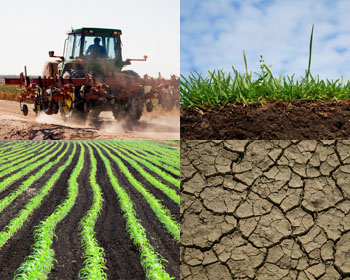A Publication of the
Applied Math and Science Education Repository

The AMSER Science Reader Monthly aims to provide educators with a useful package of information about a particular topic related to applied math and science by combining freely available articles from popular journals with curriculum, learning objects, and web sites from the AMSER portal. The AMSER Science Reader Monthly is free to use in the classroom and educators are encouraged to contact AMSER with suggestions for upcoming issues or comments and concerns at [email protected].
This month's AMSER Science Reader Monthly topic is soil science.
Our Good Earth: The Future Rests On the Soil Beneath Our Feet
Article by Charles C. Mann from National Geographic Magazine
Synopsis and resource annotations by Max Grinnell

Throughout history, humans have struggled to master the techniques of agriculture. In the past century, agronomists and others have grappled with how to master the use of soil all over the world in light of increased environmental degradation and climate change. Places from southern Wisconsin to the Loess Plateau in China are struggling to cope with the challenges presented by processes that include rapid urbanization, suburban sprawl, industrial farming techniques predicated on widespread chemical use, and at times, an indifferent public.
In this article from the September 2008 issue of National Geographic, journalist Charles C. Mann takes on some of these issues in a wide-ranging piece that addresses topics such as mega-tractors, diminishing returns from tapped-out soils, and more promising agricultural and environmental developments in the Sahel region of Africa.
Beginning with a rumination on a visit to the Wisconsin Farm Technology Days show, Mann starts by addressing the technological trends (in this case, mega-tractors) that have wide-spread ramifications for the fecundity of soil in the developed world. Here, Mann describes the double-edged sword that these massive machines present for the future of soil and agriculture in the United States and other parts of the world. What is most problematic is that these machines mash soil into an "impenetrable slab", effectively creating more soil run-off during rains, and subsequently, wide-spread erosion. Mann continues his substantial piece by taking readers inside the successes (and failures) of land reclamation in the Sahel region, the terrace farming methods in central China, and a trip to the Amazon to learn about the potential of black earth, or "terra preta" in Portuguese.
Found below is a list of useful resources that will illuminate and enhance understanding of the topics found within this article. The first three resources are broadly related to providing innovative solutions to pressing agriculture issues via scientific invention and sustainable agriculture methods. The next three resources focus in on resources that deal with coping and adjusting to environmental change and degradation.
The first entry leads to a website that profiles a vertical farm prototype proposed by Professor Dickson Despommier and his colleagues at Columbia University. The second entry will take interested parties to the homepage of the United States Department of Agriculture's Sustainable Agriculture Research and Education (SARE) group. Here visitors can learn about their funded projects and also peruse an online collection of books and bulletins. Moving on, the third entry will take users to the homepage of The Land Institute, which is an organization devoted to researching sustainable agriculture. The fourth entry leads to a helpful and thorough report on policies relating to desertification offered at a joint international conference in Algiers in 2006. The fifth entry leads to a fine lesson plan and exercise that asks students to think critically about "creating a scenario of a more humane and environmentally sound future." Finally, the last entry leads to the homepage of the Global Environment Facility which helps developing countries fund projects and programs that protect the environment. Overall, these resources should provide greater scope and help contextualize the ideas and concepts found within in the featured work. The list provides links to resource records in the Applied Math and Science Education Repository (http://amser.org).



AMSER Science Reader Monthly is published by Internet Scout at the University of Wisconsin-Madison in conjunction with the National Science Digital Library with funding from the National Science Foundation. If you have questions or suggestions please e-mail us at [email protected].